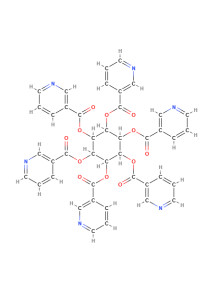Inositol Hexaniacinate (Inositol Nicotinate, No Flush Niacin)
a compound that has been investigated for various potential health benefits, primarily related to cardiovascular health and circulation.
a compound that has been investigated for various potential health benefits, primarily related to cardiovascular health and circulation.
Inositol Hexanicotinate: Exploring its Potential Health Benefits and Supporting Research
Inositol hexanicotinate, often marketed as a "no-flush" form of niacin (Vitamin B3), is a compound that has been investigated for various potential health benefits, primarily related to cardiovascular health and circulation. While research has explored its effects on a range of conditions, the most notable areas of study focus on its impact on lipid profiles and blood flow.
Impact on Lipid Profiles:
Several studies have investigated the effects of inositol hexanicotinate on cholesterol and triglyceride levels. As it is metabolized in the body to release niacin, it is thought to exert similar lipid-lowering effects to nicotinic acid, but with a reduced risk of the common "niacin flush."
Research suggests that inositol hexanicotinate may help improve lipid profiles by:
- Lowering Total Cholesterol and LDL ("Bad") Cholesterol: Some studies have indicated a reduction in total and LDL cholesterol levels with inositol hexanicotinate supplementation.
- Lowering Triglycerides: A decrease in triglyceride levels has also been observed in some research.
- Raising HDL ("Good") Cholesterol: Some findings suggest that inositol hexanicotinate may contribute to an increase in HDL cholesterol, which is considered beneficial for heart health.
Research Citations on Lipid Profile:
- A study published in Circulation (Abstract 14436, Originally Published 11 Nov 2019) investigated inositol hexanicotinate as an alternative to niacin for dyslipidemia. The findings suggested that inositol hexanicotinate was safe and effective in improving lipid profiles, including significantly reducing triglycerides, VLDL, total cholesterol, and LDL cholesterol, while significantly increasing HDL cholesterol after 12 weeks of therapy in patients with low HDL levels. (Citation: Circulation. 2019;140:A14436)
- Another study, "Efficacy and safety of IHN (Inositol hexanicotinate) in Improving Serum Lipid Profile in Patients with Low HDL Levels," similarly concluded that inositol hexanicotinate could be an efficacious and safe therapeutic option for raising HDL levels without causing significant side effects like flushing. (Citation: Medical and Research Publications)
- However, not all research has shown a significant impact on lipid levels. A study comparing wax-matrix extended-release niacin to inositol hexanicotinate in individuals with mild to moderate dyslipidemia found that while the extended-release niacin significantly improved lipid profiles, inositol hexanicotinate showed no significant improvement and no evidence of bioavailability in that particular study. (Citation: PubMed.gov, PMID: 23351578) This highlights the need for further research to clarify the extent of its effects and optimal formulations.
Effects on Blood Circulation:
Inositol hexanicotinate has also been explored for its potential to improve blood circulation, particularly in conditions characterized by poor blood flow. The niacin component is known for its vasodilatory properties, meaning it can help widen blood vessels.
Conditions for which inositol hexanicotinate has been studied include:
- Raynaud's Phenomenon: This condition causes reduced blood flow to the fingers and toes, often in response to cold or stress. Some research suggests that inositol hexanicotinate may help improve symptoms.
- Intermittent Claudication: This is pain in the legs due to poor circulation during exercise. Inositol hexanicotinate has been investigated for its potential to increase walking distance and reduce symptoms.
Research Citations on Circulation:
- A double-blind randomized placebo-controlled trial published in PubMed (PMID: 3044673) investigated Hexopal (inositol hexanicotinate) in patients with primary Raynaud's disease. The study found that the group receiving Hexopal reported feeling subjectively better and had demonstrably shorter and fewer attacks of vasospasm during cold weather compared to the placebo group. (Citation: PubMed.gov, PMID: 3044673)
- RxList and WebMD also mention the use of inositol nicotinate (inositol hexanicotinate) for circulation problems like Raynaud's and intermittent claudication, noting that some research suggests modest improvement in Raynaud's symptoms, although the effectiveness for intermittent claudication and other circulatory issues remains controversial with conflicting results. (Citations: RxList: Inositol Nicotinate, WebMD: INOSITOL NICOTINATE Overview)
Other Potential Benefits:
While the evidence is less robust, inositol hexanicotinate and inositol in general have been explored for other potential benefits, including:
- Skin Health: Some information suggests potential use for certain skin conditions, but the research specifically on inositol hexanicotinate for these uses is limited. A systematic review on inositol for dermatological disorders showed promising results for acne and hirsutism, but this primarily focused on inositol and not specifically inositol hexanicotinate, and noted limited evidence for other conditions like psoriasis and dermatitis. (Citation: Journal of Integrative Dermatology: Inositol for Treating Dermatological Disorders: A Systematic Review)
- Anxiety and Mood Disorders: Inositol plays a role in neurotransmitter signaling, and some research on inositol has explored its potential for anxiety and depression. However, studies specifically on inositol hexanicotinate for these conditions are limited and have shown mixed results. (Citations: Healthline: 5 Evidence-Based Health Benefits of Inositol, PubMed Central: The Biomedical Uses of Inositols, PubMed Central: Neurobiology and Applications of Inositol in Psychiatry, Verywell Mind: Inositol: Benefits, Side Effects, Dosage, Interactions)
| Mechanism | - |
| Appearance | - |
| Longevity | - |
| Strength | - |
| Storage | - |
| Shelf Life | - |
| Allergen(s) | - |
| Dosage (Range) | - |
| Recommended Dosage | - |
| Dosage (Per Day) | - |
| Recommended Dosage (Per Day) | - |
| Mix Method | - |
| Heat Resistance | - |
| Stable in pH range | - |
| Solubility | - |
| Product Types | - |
| INCI | - |
Purchase History for
Cart
No products



